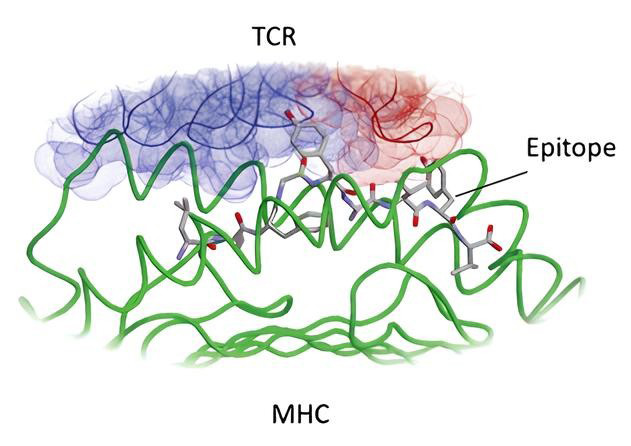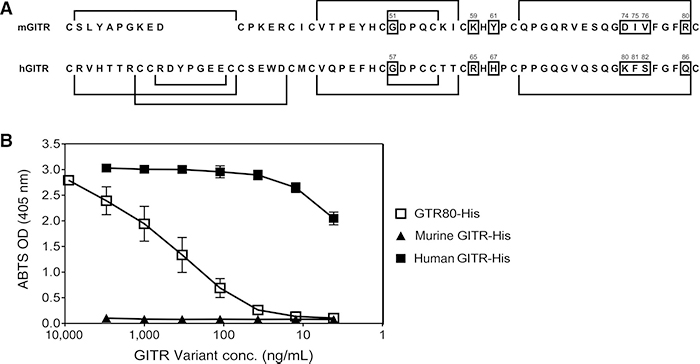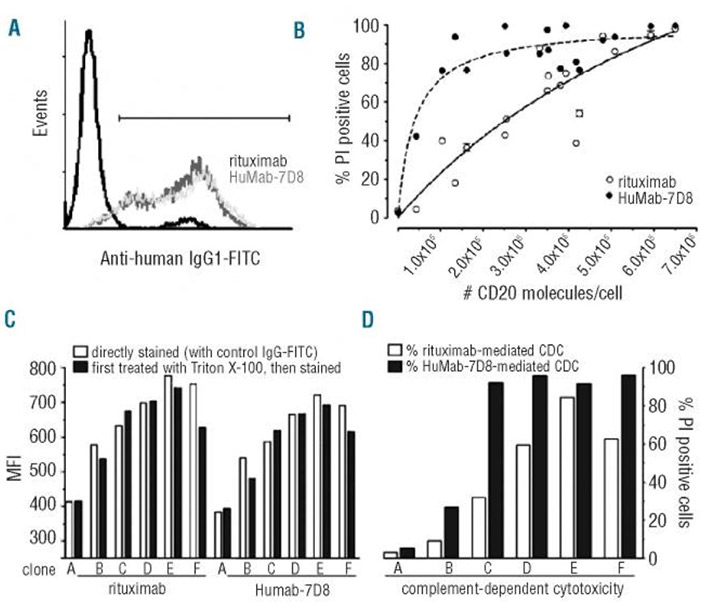Epitope Mapping
Background
Epitope mapping is the process of identifying and characterizing the specific regions (epitopes) on an antigen that are recognized and bound by antibodies or T - cell receptors. It is a crucial technique in immunology, molecular biology, and vaccine development. Epitopes are the parts of an antigen that interact with the variable regions of antibodies or the T-cell receptor (TCR) on T cells. For example, in the case of a viral protein, the epitope could be a small peptide sequence on the surface of the virus that is recognized by a particular antibody. Understanding the structure and location of these epitopes helps in designing vaccines and therapeutics that specifically target pathogens or abnormal cells.

Figure 1. T-cell epitope recognition. (Perosanz et al., 2019)
Applications of Epitope Mapping
-

Vaccine Development
Identifies key immunogenic regions of pathogens to design targeted vaccines, particularly subunit vaccines, offering strong immunity with reduced safety risks compared to whole-pathogen approaches.
-

Monoclonal Antibody Development
Defines precise binding sites to improve the specificity and efficacy of monoclonal antibodies, minimizing off-target interactions and enhancing therapeutic precision.
-

Understanding Immune Responses
Reveals how the immune system recognizes antigens, helping elucidate antigen-antibody interactions and disease mechanisms in autoimmune and allergic conditions.
-

Biosimilar & Biobetter Development
Supports structural and functional comparison of biosimilars to originators, ensuring similar efficacy and safety profiles. Also guides biobetter optimization for enhanced performance.
-

Autoantibody Profiling
Maps autoimmune targets to uncover disease-specific epitopes, aiding diagnosis, stratification, and the development of targeted immunotherapies.
-

Protein Engineering & Mutagenesis
Informs rational design of proteins and antibodies by pinpointing critical epitope residues, facilitating affinity maturation, deimmunization, and functional optimization.
Epitope mapping has become more and more vital in both vaccine and antibody drug development. Knowledge on epitope of an antibody will largely facilitate your drug design and patent application. Based on our advanced peptide library platform, Creative BioMart provides a comprehensive series of Epitope Mapping Services to fulfill customers' demand.
What We Offer?
Our platform is designed to provide detailed insights into the antigenic regions that are essential for antibody binding, supporting rational design and downstream validation. Whether your goal is to characterize monoclonal antibodies, evaluate antigenic sites, or confirm binding domains, our tailored solutions are optimized for performance and accuracy.
|
Type |
Cytokine |
|---|---|
|
Binding Activity Confirmation |
ELISA/WB confirm the binding of submitted antigen and antibody. |
|
Glycosylation Analysis (Optional) |
Compare the antibody-antigen binding activity of deglycosylation antigen with the submitted antigen. |
|
Overlapping Peptide Library Design |
Overlapping peptides are synthesized according to the protein sequences provided by the customer. |
|
Peptide Screening and Detection |
Screening of peptide library against customer samples: control detection (optional) and target detection. |
Service Procedure

Why Choose Us?
- High-Resolution Peptide Mapping: Overlapping peptide arrays enable precise mapping of linear epitopes, revealing fine structural details crucial for antibody development and functional characterization.
- Glycosylation Insights: Optional glycosylation analysis provides additional structural context, identifying glycan-dependent epitopes critical for therapeutic antibody binding and immune recognition.
- Flexible Detection Platforms: We support diverse assay formats—ELISA, SPR, Western blot, and more—to accommodate different sample types and research requirements.
- Customizable Workflows: Tailored experimental workflows are designed to suit your specific antibody and antigen, ensuring targeted, relevant, and efficient epitope identification.
- Unparalleled Accuracy: Optimized protocols and stringent controls minimize background noise and nonspecific binding, delivering highly accurate and reproducible mapping results.
- End-to-End Solutions: We offer one-stop services for mapping linear and conformational epitopes, covering everything from peptide synthesis to data delivery.
Case Study
* NOTE: We prioritize confidentiality to safeguard our clients’ technology and intellectual property. As an alternative, we present selected published research articles as representative case studies. For details on the assay services and products used in these studies, please refer to the relevant sections of the cited literature.
Case 1: MK-4166—A clinical agonistic antibody that targets human GITR
Sukumar et al., 2017. doi:10.1158/0008-5472.CAN-16-1439
GITR is a costimulatory receptor that enhances immune responses, and its activation via the murine antibody DTA-1 has shown potent antitumor effects by reducing Treg-mediated suppression. To translate this approach to humans, MK-4166, ahumanized IgG1 monoclonal antibody targeting a DTA-1–analogous epitope on human GITR, was developed. MK-4166 promoted the proliferation of naïve and tumor-infiltrating T cells, inhibited Treg induction and suppressive function, and activated NFκB and Erk signaling pathways, as indicated by increased DUSP6 expression and reduced FOXP3 mRNA in human Tregs.
Epitope mapping revealed key differences between mouse and human GITR, with MK-4166 binding only human and cynomolgus GITR (high affinity: ~5–7 pmol/L), but not murine GITR. These findings support the clinical potential of MK-4166 as an immunotherapeutic agent by enhancing effector T cell activity and attenuating Treg-mediated suppression in the tumor microenvironment.

Figure 2. Epitopes of DTA-1 and MK-4166. A, Partial sequence alignment of mouse and human GITR. Residues critical for DTA-1 binding to mouse GITR and MK-4166 binding to human GITR are boxed. B, Binding of the parental mouse clone of MK-4166 to GTR80, human GITR-His, and mouse GITR-His as determined by ELISA. (Sukumar et al., 2017)
Case 2: HuMab-7D8—A monoclonal antibody directed against the membrane-proximal small loop epitope of CD20
Van Meerten et al., 2010. doi:10.3324/haematol.2010.025783
To address resistance or relapse following the use of rituximab to treat non-Hodgkin's lymphoma, the efficacy of alternative CD20-targeting monoclonal antibodies, HuMab-7D8 and ofatumumab—both of which recognize a distinct membrane-proximal epitope of the CD20 molecule—was investigated using a model system in which CD20 expression was uniformly modulated via retroviral gene transduction and clonal selection, ensuring that CD20 level was the sole variable.
In vitro assays demonstrated that HuMab-7D8 was capable of inducing complement-dependent cytotoxicity in CD20low cells resistant to rituximab, and in vivo studies employing a luciferase-tagged xenograft model confirmed that HuMab-7D8 treatment not only extended survival comparably to rituximab but also achieved complete eradication of CD20-expressing cells, including those in bone marrow and peripheral sites, whereas rituximab-treated animals retained residual CD20low cells. These findings suggest that antibodies targeting the membrane-proximal epitope of CD20 may provide a promising strategy to overcome rituximab resistance and warrant further clinical investigation.

Figure 3. Resistance to rituximab-mediated killing is not explained by ineffective translocation into lipid rafts. (A) FACS-analysis of HuMab-7D8 and rituximab binding to CEM-CD20 cells at saturating concentrations. (B) CDC efficiency correlates with CD20 expression; HuMab-7D8 is more effective than rituximab at lower CD20 levels. (C) Lipid raft association was assessed by anti-IgG1-FITC staining before and after Triton X-100 treatment. (D) CDC induced by HuMab-7D8 exceeds that of rituximab, particularly in CD20low clones. (van Meerten et al., 2010)
Customer Testimonials
-
"We needed to pinpoint the precise epitope on a monoclonal antibody targeting PD-L1, and Creative BioMart’s team delivered beyond expectations. Their overlapping peptide strategy and expert consultation helped us refine our antibody candidate for increased specificity."
— R&D Director | Mid-Sized Pharmaceutical Company
-
"Creative BioMart’s epitope mapping services helped us identify a critical conformational epitope on a therapeutic antibody for a neurodegenerative disease target. The glycosylation analysis option was a huge plus—it clarified an unexpected binding pattern. The entire process was smooth, professional, and incredibly insightful."
— Principal Scientist | Biotech Startup
-
"We were investigating cross-reactivity issues in our anti-IL-6 antibody, and Creative BioMart's high-resolution mapping solved the puzzle. Their peptide array and structural insight revealed a previously overlooked linear epitope. This service saved us months of trial-and-error in the lab."
— Immunology Research Lead | Academic Medical Center
-
"As a CRO, we rely on reliable partners, and Creative BioMart impressed us with their in-house peptide synthesis and customizable workflow. We needed fine mapping for a bispecific antibody project, and their team provided clear, publication-quality data that helped us meet a tight deadline."
— Senior Scientist | Global CRO
-
"The flexibility in Creative BioMart’s detection formats allowed us to use both serum and cell-based samples in our epitope analysis. We appreciated the detailed consultation and the ability to map multiple antibody clones targeting a tumor-specific antigen. This helped shape our clinical candidate selection."
— Director of Translational Research | Cancer Immunotherapy Company
FAQs
-
Q: What types of epitopes can you map—linear, conformational, or both?
A: We specialize in both linear and conformational epitope mapping using overlapping peptides, structural analysis, and optional glycosylation studies for deeper insight into binding specificity. -
Q: Can I customize the workflow based on my antibody and target antigen?
A: Yes! We offer fully customizable workflows tailored to your antibody type, species, and antigen complexity—ensuring high-resolution and meaningful results. -
Q: What formats and sample types do you support for detection?
A: We provide flexible detection platforms including ELISA, SPR, and cell-based assays that accommodate serum, purified antibodies, and even hybridoma supernatants. -
Q: How accurate is your mapping approach?
A: Our optimized assay design minimizes nonspecific interactions and delivers unparalleled accuracy in identifying fine epitope structures and key binding residues. -
Q: Can you help us identify cross-reactive or off-target epitopes?
A: Absolutely. Our mapping approach is excellent for identifying cross-reactivity and off-target binding—crucial for therapeutic antibody development and validation.
-
Q: Do you provide end-to-end support for the project?
A: Yes! Our experienced technical team offers comprehensive project consultation—from initial design through data interpretation and reporting.
Resources
Related Services
- Recombinant Antibody Production Services
- Enzyme/Antibody conjugation
- Protein Engineering Services
- Enzyme Activity Assay
- Protein Glycosylation Labeling Service
- Direct Peptide Reactivity Assay (DPRA)
- Drug Discovery Screening
Related Products
References:
- Gómez Perosanz M, Russo G, Sanchez-Trincado Lopez JL, et al. Computational immunogenetics. In: Encyclopedia of Bioinformatics and Computational Biology. Elsevier; 2019:906-930. doi:10.1016/B978-0-12-809633-8.20452-4
- Sukumar S, Wilson DC, Yu Y, et al. Characterization of mk-4166, a clinical agonistic antibody that targets human gitr and inhibits the generation and suppressive effects of t regulatory cells. Cancer Research. 2017;77(16):4378-4388. doi:10.1158/0008-5472.CAN-16-1439
- Van Meerten T, Rozemuller H, Hol S, et al. HuMab-7D8, a monoclonal antibody directed against the membrane-proximal small loop epitope of CD20 can effectively eliminate CD20low expressing tumor cells that resist rituximab-mediated lysis. Haematologica. 2010;95(12):2063-2071. doi:10.3324/haematol.2010.025783
Contact us or send an email at for project quotations and more detailed information.
Quick Links
-

Papers’ PMID to Obtain Coupon
Submit Now -

Refer Friends & New Lab Start-up Promotions

